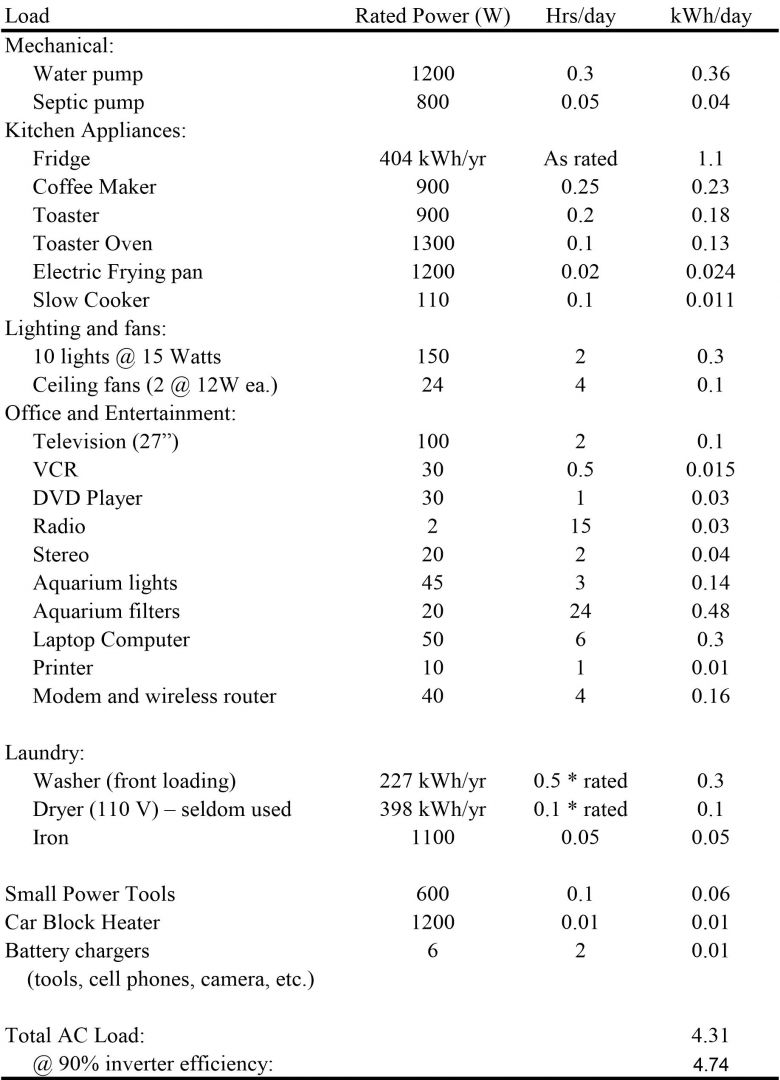How to Calculate your Energy Load
The size of the solar power system you need depends on how much energy you use. The first step in designing a solar power system for your house is to figure out how much power you need to run the various systems and appliances.
Grid-tied Systems
If you are already connected to utility power, this is quite easy. A look at your power bill will tell you how many kWh you are using in any one month. However, the amount of power you use at different times of the year will vary and so will the amount of power that can be harvested from the solar panels. The total power you used over the year is a better number for sizing your solar array, and your usage over several years would give an even more accurate indication.
Off-Grid Systems
If you do not have utility power and it is prohibitively expensive to bring in, then a off-grid system may be a good choice. Sizing this system is a lot more complicated. You will have to make a list of all the appliances and other loads that you expect to use and determine the total power that will be needed.Types of Loads
Loads can be continuous (running 24 hours a day), or intermittent. Many loads - such as a refrigerator, toaster, or vacuum cleaner - use a large amount of power but only for short periods. The best way to figure out how much power your appliances need is to measure them with a power usage meter (the Kill A Watt meter is one example). Often, something that draws little power (such a standard light bulb at 60 watts) will use more power per day if left on all day than a very large intermittent load such as a coffee maker drawing 900 watts for 20 minutes. For example:- A 60W light bulb, 60W x 24 hrs = 1440 Whr.
- A coffee maker uses 900W x 1/3 hr = 300 Whr.
There are some loads that are not obvious and are easily overlooked when calculating load requirements:
- The inverter will draw a certain minimum amount of power.
- Anything that has a remote control (like the TV or stereo) draws some power at all times so that the remote will be ready to turn it on at anytime.
- Computers may also draw power even when they are not turned on.
Once you know the energy loads you're using, the total amount of energy that you use and what the solar array will have to supply, can be calculated.
Calculating Your Total Load
Multiply the power used by each appliance times the hours per day that you use it – this gives you the total number of kWh per day for that appliance. Add up all the appliances and you will have the total number of kWh that you need per day. Adjust the total number for the efficiency of the inverter, typically 90%. Definitions:- Power is given in watts (W) – a thousand watts is a kilowatt (kW).
- If you use a kW of power for one hour this is a kilowatthour (kWH). When you look at your utility bill you will see that the power you have used over the month is listed as some number of kWH.
An Example Load Calculation used for the Suncatcher Solar Prototype House

Notes:
- The energy rating in KWh/year is based on 416 “Normal Cycle” operations per year and includes the energy required to heat the water. This is more than one load per day, which is not necessary for two people. The usage estimate has been adjusted accordingly.
- This energy rating in KWh/year is also based on 416 operations per year. Our usage would be less based on fewer loads through the washer and we often hang the clothes to dry. Again, usage has been adjusted accordingly.
What's Next?
Now that you know how much power you use, we can design a solar power system tailored to your lifestyle. Check out more information on grid-tied systems or off-grid systems and contact us for a free estimate.

 See Our Projects
See Our Projects

